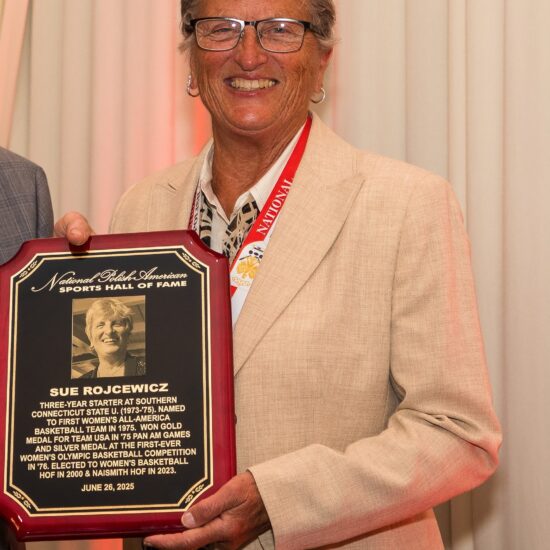
Sue Rojcewicz
Description
Inducted June 26, 2025
A 5’7” guard at Southern Connecticut State University, Sue Rojcewicz led her team to a pair of third place finishes at the national championships in 1973 and 1974. In 1975, she was named All-America on the first-ever women’s basketball All-America Team. She played for the United States in the 1975 World Championship and on the gold medal winning Pan American team in 1975. As a member of the 1976 Olympic team – the first time that Women’s basketball would be played at the Olympics – she averaged 7.2 points and 3.8 assists, as the team beat Czechoslovakia and took home the silver medal. Rojcewicz was inducted into the Women’s Basketball Hall of Fame in 2000, and joined her 1976 Olympic team mates with induction into the Naismith Basketball Hall of Fame in 2023.
INDUCTION BANQUET PROGRAM STORY — June 26, 2025
Sue Rojcewicz: A Polish-American Trailblazer on Basketball’s Biggest Stage
By: Mike Horan
NPASHF Board Member
In her hometown of Worcester Massachusetts, long before Olympic medals or Hall of Fame inductions, a young girl spent her days playing pick-up basketball with her cousins on a hoop mounted to a garage.
That girl would one day be a part of the first-ever United States Women’s Basketball Olympic Team, winning silver in the 1976 games, and help change the course of women’s basketball in America.
On June 26, 2025, Sue Rojcewicz will receive another honor to her already illustrious career, an induction into the National Polish American Sports Hall of Fame, where she’ll become just the fifth women’s basketball player ever honored.
Rojcewicz’s first basketball court wasn’t fancy. It was a neighborhood driveway. But for her, it was where her love of the game began.
“We played hours and hours in the neighborhood of Worcester,” she said
At a time when girls’ basketball was still played with six players and limited dribbling, Rojcewicz was already ahead of the game. While many of her peers were adjusting to the rule changes post Title IX that finally allowed full-court play, Rojcewicz had already been running 5-on-5 with the boys at Vernon Hill Park.
She played two years of high school basketball, leading her team to a State Championship before pausing her athletic career to see if she had a vocation.
“Believe it or not, I decided to go into the convent,” she said. “My mother pulled me out, which was probably a good thing.”
That decision paved the way for Rojcewicz to land at Southern Connecticut State University, one of the nation’s premier women’s basketball programs at the time. A three-sport athlete in basketball, softball, and field hockey, Rojcewicz was still exploring her potential. But when it was announced the Olympic Games would allow women to compete for the first time, she knew basketball was where she wanted her focus to be.
Determined to sharpen her game, Rojcewicz asked her coach to help her find a summer camp. That search led her to the Poconos Invitational Basketball Camp in Stroudsburg, Pennsylvania, a decision that would change her life.
“There were some of the best basketball players from the East Coast there,” she said. “The owners took me aside and said, ‘Sue, if you really want to become good, you’ve got to work on your ball handling and your jump shot.’”
As a camp counselor, she’d practice for five hours a day, twelve weeks straight, teaching students, working on her own craft and learning from visiting pros. By the end of that summer, her coach had moved her from forward to guard. Her game had transformed, and she was ready to stake her claim on the Olympic team.
In 1974, Rojcewicz tried out for the first U.S. women’s team, but failed to make the cut.
“I was totally intimidated by Annie Meyers,” she said.
She returned to the Poconos camp the next summer, this time playing one-on-one all summer against a 6’2” friend who could jump and replicate Meyers’ game, continued to perfect her own craft and readied herself for the next Olympic tryout in 1975.
Out of hundreds of players across four regional tryouts, just 48 were invited to a final camp in Warrensburg, Missouri. Every night, names were posted to the wall. Make the list, and you stayed another day.
“The tension was so high every night,” she said. “I couldn’t believe it (when my name was on the final list). I was over the moon. Unimaginable how awesome it was.”
From camp, the United States Olympic team competed in the 1975 FIBA World Championships, a hostile environment that gave the US a taste of international ball. The team failed to get out of its pool, finishing eighth. But the experience hardened them.
Then came the 1975 Pan American Games, where Team USA went undefeated and captured gold.
“That was when we really started to get it together,” she said. “We were building momentum.”
Despite their Pan Am victory, the United States’ Olympic spot wasn’t guaranteed and Team USA still had to qualify for the Olympic Games. Just 10 days before the 1976 Games, Rojcewicz and her team competed in a last-chance tournament in Hamilton, Ontario. The top two teams among a pool of 23 countries would advance. The U.S. won the tournament and officially had made the Olympics.
When the Olympics finally began in Montreal, the team stumbled out of the gate with a loss to Japan.
“We were flat,” Rojcewicz said. “The exhilaration of finally making it… there was a letdown.”
Still, they rallied. Wins against Canada and Bulgaria put them in contention, but they had to beat Czechoslovakia in the final game to medal or they’d go home with nothing. At halftime, they trailed by five, but the United States ran away with the game in the second half, winning by 16 points, earning a silver medal in the first-ever women’s basketball tournament at the Olympics.
“We were over the moon,” Rojcewicz said. “We had special chemistry. We were just kids, 17 to 23 years old, playing against 30-year-old women with a decade of international experience. We didn’t know any better. We were just playing our hearts out.”
In an unforgettable moment, Rojcewicz’s mother rushed out of the stands, past security and embraced her daughter at center court.
“It was too cool,” Rojcewicz said. “It was great.”
That silver medal did more than validate their talent, it helped launch a new era for women’s basketball.
“Title IX was huge,” she said. “Once the NCAA took over and started offering scholarships and hiring full-time coaches, the game exploded.”
Rojcewicz was one of those pioneers. She coached at the college level, mentored countless players and helped shape the future of the sport.
In 2000, Rojcewicz was inducted into the Women’s Basketball Hall of Fame. In 2023, the entire 1976 Olympic team was inducted into the Naismith Basketball Hall of Fame. And now, in 2025, she joins another elite club: the National Polish American Sports Hall of Fame.
“I always knew it was special for me to be Polish,” she said. “To be recognized by my people is just great and so special.”
From a neighborhood driveway in Worcester to the Olympic podium in Montreal, Sue Rojcewicz’s journey helped pave the way for generations of women in basketball. Her induction into the National Polish American Sports Hall of Fame is more than a personal honor—it’s a tribute to her roots, her resilience and the impact she made on and off the court.
She didn’t just play the game. She helped change it, and her legacy will continue to inspire for years to come.
Categories
- 2025
- Basketball


